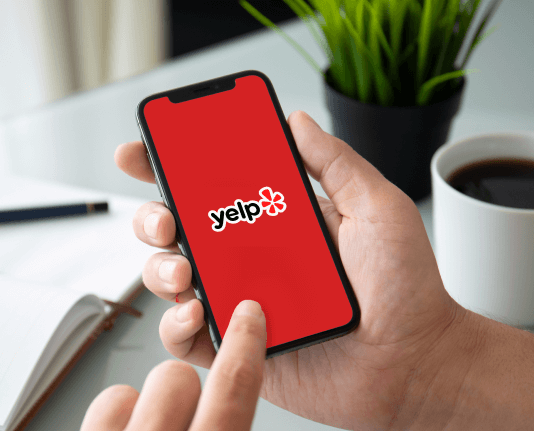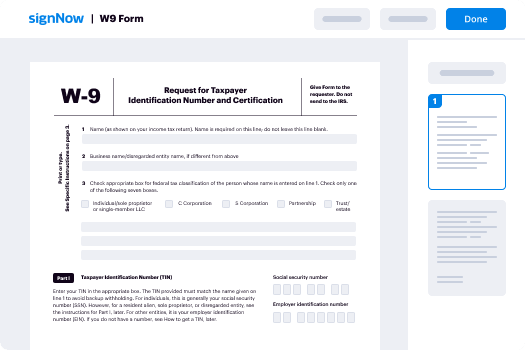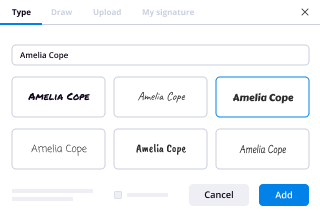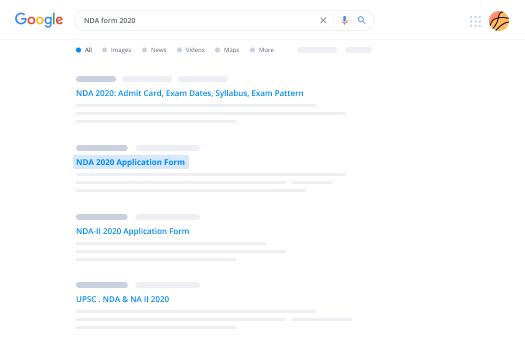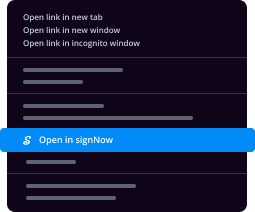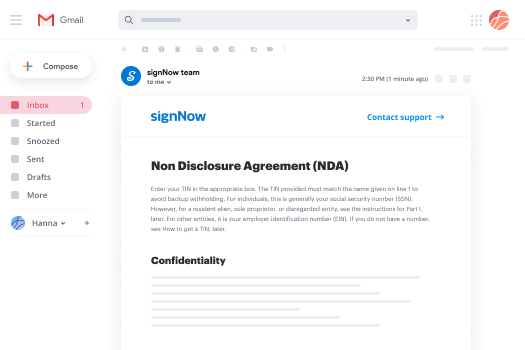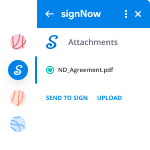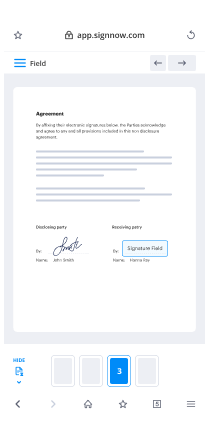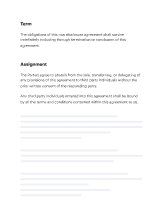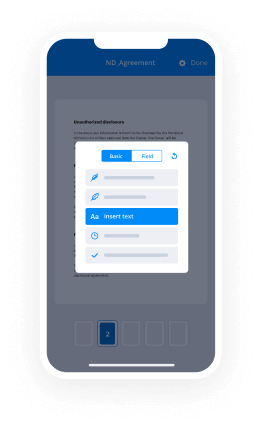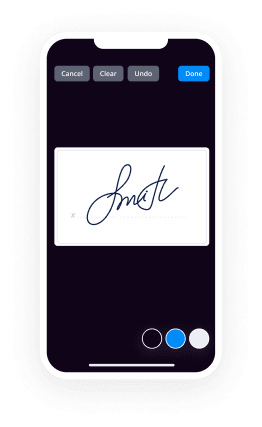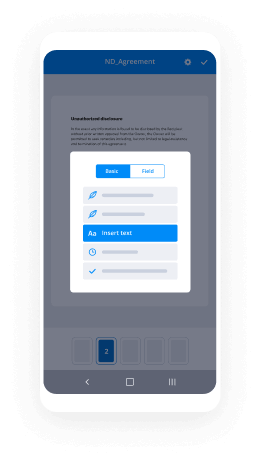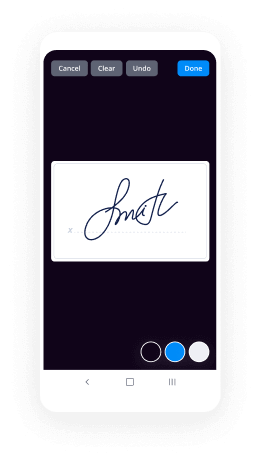How To Set Up eSign in Android
Contact Sales
Make the most out of your eSignature workflows with airSlate SignNow
Extensive suite of eSignature tools
Robust integration and API capabilities
Advanced security and compliance
Various collaboration tools
Enjoyable and stress-free signing experience
Extensive support
Keep your eSignature workflows on track
Our user reviews speak for themselves






How to electronically sign on Android
Understanding how to electronically sign on Android can greatly enhance your document signing experience. With airSlate SignNow, you can conveniently create, send, and oversee eSignature workflows directly from your mobile device. This guide will lead you through the process to begin eSigning using airSlate SignNow.
How to electronically sign on Android: Step-by-step guide
- Visit the airSlate SignNow website using your mobile browser.
- Set up a free account or log into your current account.
- Upload the document you intend to sign or circulate for signatures.
- If you wish to reuse this document, think about saving it as a template.
- Open the document to modify: add fillable fields or input required information.
- Sign the document and incorporate signature fields for additional signers.
- Click 'Continue' to set up and send an eSignature invitation.
To sum up, grasping how to electronically sign on Android with airSlate SignNow enables you to optimize your signing procedure. The platform provides a user-friendly interface, making it perfect for organizations aiming to boost productivity and decrease turnaround times.
Ready to enjoy the advantages of airSlate SignNow for yourself? Begin your free trial today and see how simple it is to manage your document signing requirements!
How it works
Rate your experience
-
Best ROI. Our customers achieve an average 7x ROI within the first six months.
-
Scales with your use cases. From SMBs to mid-market, airSlate SignNow delivers results for businesses of all sizes.
-
Intuitive UI and API. Sign and send documents from your apps in minutes.
A smarter way to work: —how to industry sign banking integrate
FAQs
-
What is the best way to e sign on Android using airSlate SignNow?
To e sign on Android using airSlate SignNow, simply download the app from the Google Play Store. After installing, upload your document, tap on the signature field, and create your signature. This user-friendly process makes it easy to e sign on Android anytime, anywhere.
-
Is airSlate SignNow free to use for e-signing on Android?
airSlate SignNow offers a free trial that allows you to explore how to e sign on Android without any cost. However, for ongoing use and access to premium features, you will need to choose a paid plan that fits your business needs.
-
Can I integrate airSlate SignNow with other applications on my Android device?
Yes, airSlate SignNow provides seamless integrations with various apps, including Google Drive and Dropbox, enhancing your ability to e sign on Android. These integrations allow you to easily access and manage your documents from multiple platforms.
-
What features does airSlate SignNow offer for e-signing on Android?
airSlate SignNow offers a range of features for e-signing on Android, including document templates, signature requests, and real-time tracking. These tools streamline the signing process, making it efficient and straightforward for users.
-
How secure is airSlate SignNow for e-signing on Android?
Security is a top priority for airSlate SignNow, which employs advanced encryption protocols to ensure your documents are protected. When you learn how to e sign on Android with our platform, you can be confident that your sensitive information remains safe.
-
Can I use airSlate SignNow to collect multiple signatures on an Android device?
Absolutely! airSlate SignNow allows you to collect multiple signatures on a single document, making it perfect for contracts and agreements. This feature simplifies the process of e signing on Android, ensuring all parties can easily add their signatures.
-
What types of documents can I e sign on Android with airSlate SignNow?
You can e sign various document types on Android with airSlate SignNow, including PDFs, Word documents, and image files. This versatility gives you the flexibility to handle different paperwork efficiently while learning how to e sign on Android.
-
What should every person be knowledgeable about or be proficient in by the age of 20? Can we please create an answer wiki for th
A big part of the answer to this question depends on the place and society this 'every' person belongs to. However, I would try to give a more universal answer here:Driving and basic car upkeepManaging resources and budgeting; money, time, health, energyManaging people, creating and taking care of relationships; friends, family, colleagues etc., how to treat a lady wellLogic and critical thinkingBasic usage of computer and internet; how to use at least one OS, some necessary applications (word processor, spreadsheet etc.), how to Google Everyday mathematicsThe fact that you can never be good enoughThe fact that hardwork is more important than intelligence and good fortuneHow to make independent/wise choices and prioritizingBasic survival skills; building a fire, cooking, basic first aid (CPR and Heimlich maneuver)When to fight and how to do itPacking lightRecognizing one's limits; alcohol/drug usage, frankness with people, independence of speech and action, when you are a guest somewhereBasic physical training; push-ups, sit-upsHow to play at least one sportGeography; names and locations of major countries, cities, physical features of the world and especially of the little bubble you live inHow to smileBehavioral control; when to promise, how to negotiate, how to be a good house guestTaking basic security precautions; physical and onlineTaking care of one's physical, mental, emotional health
-
How can I promote an e-commerce website?
Would you think twice to buy from a store that has been recommended by a friend? NO!Word of mouth or referral marketing is when you entice your existing customers to signNow out and refer other customers in exchange for a lovely reward. Referrals can be done through social media such as Facebook, Twitter, Instagram, through chat apps such as WhatsApp and Facebook Messenger and by email invites. Such engagement will create a warm community around your e-commerce store that will nurture future leads until they eventually buy from you.Dollar Shave Club as a prime example of referral marketing…What do they do?Everything you need in the bathroom – from razor blades to grooming products – automatically delivered to your door.Referral program strategyOnly Dollar Shave Club members (that is those paying the monthly subscription fee) can refer their friends. On successfully referring a friend, you will get credit points that can be redeemed in future purchases from Dollar Shave Club.The Dollar Shave Club referral campaign was set in place as from the get-go. When launching back in 2012. Dollar Shave Club got a ton of publicity through their sarcastic and funny intro video featuring CEO Michael Dubin. The referral program helped in creating a viral loop, making sure converted customers tell their friends about their latest subscription. In fact, in a week Dollar Shave Club got over 25,000 paying users.What we really liked, about Dollar Shave Club referral program is how easy it is to understand what you will get back. Basically, when you refer a friend you will be getting credit which can spend at the store. That simple. The more you refer the more discounted stuff you will be getting any time you need them. This is a very important point to keep in mind when designing a referral campaign. KISS - keep it simple stupid.What strategies can you use to boost sales through referrals?Here are some of the advice we give out to our customers at EarlyParrot. EarlyParrot is a referral marketing platform that can be easily integrated within your existing e-commerce sales funnel.Strategy #1: Invite past buyersPast buyers have already converted. So they are already convinced of the quality of your products and of the excellent service you provide. Buying again from your store might be just an email away.It would be great to give them a discount and get them to buy again from your store. But it would be even better if you can get them to bring along a friend to purchase from your store. For instance, a very common reward is“10% off your next purchase for referring afriend who will get $10 off the first purchase”The aim of this kind of referral campaign is to make it easy for your referrers to convince their friends to by from your store and hence benefiting from a discount themselves. After all who does not like a free $10 off when being referred to a store!!!Strategy #2: Pitch in Thank You pageHow much time have you invested in designing you Thank You page? Let me guess? NADA. The thank you page is yet another opportunity to push your referral program, by offering enough incentive to your newly acquired customer to share their latest purchase with friends.But what can you offer to a converted customer? Think of a minor upgrade that you can add to their purchase in exchange for a referral. Minor upgrades can be:Priority shipping at no extra costComplimentary product added to shipment for free.Samples of complimentary products for free. Usually used by fragrances and beauty products.Voucher with discounts on future purchasesMake sure you make good use of your thank you pages. Don’t do like 99% of the stores who simply waste precious real estate space by not pushing to get referrals in their thank you page.Strategy #3: Referral link with every newsletter email you sendAlmost 100% sure that you are sending some kind of newsletter, highlighting new products to be released or currently being sold at your Ecommerce store. Newsletters are a great way how to keep in touch with your existing and future customers who have shown interested in your store.Make sure to always include two very important links in each email you send out:Share Page URL: The share page URL is where your newsletter subscribers can go to share with their friends and acquittances via email invites, social media shares or else by sending private messages on chatting apps!Unique Referral URL: The unique referral URL is associated with the referrer. This link is tracked so that if someone visits your Ecommerce store through it and converts, a referral is attributed to the associated referrer.By always including these two very important URLs and highlighting the rewards waiting to be redeemed in exchange for referrals, you will ensure you are constantly giving enough exposure to your referral marketing campaign through your email list.Strategy #4: Referrals integrated within your Ecommerce AccountMost Ecommerce platforms have a logged in area. Becoming a customer involves filling in important information such as first name, last name and email. This is enough for an Ecommerce platform to create a profile for a customer, keeping on file information such as shipping and billing addresses and payment information.Having a logged in area for your customers gives you plenty of room how you can integrate and promote your referral marketing campaign. You can add a section, which is totally dedicated to referral marketing, making it easy for your existing customers to refer their friends. Through this referral section, your referrers will also be able to track how far are they from getting their next reward.Strategy #5: Repeat purchase through referral marketingWhen planning your referral marketing campaign for your Ecommerce store, make sure you are witty with your choice of rewards. Do not give out a reward in one chunk such as $50 off your next purchase. Buyers will dispose off the voucher and might not come back to your store. Spread the reward out for both the referrer and the referral onto multiple purchases. For instance, $20 off your next 3 purchases, instead of $60 off discount. This will push for repeat purchase from both the referrer and the referral.We see a lot of stores offering a reward along these lines:“$10 off for you and your friend”Such referral marketing campaign will not give out the best results possible. New referrals will most likely redeem their first-time referral voucher and will not come back. We recommend you give out more say $20 to both referrer and referral but split into 2 purchases. This way you are giving the same discount per purchase but you are signNowly increasing your chances of getting repeat purchases.Strategy #6: Fear Of Missing Out (FOMO) for upcoming productsWe are sure you are aware how much FOMO is important to sell, especially when you would like to promote upcoming products. We have helped Ecommerce store to continuously, week after week, use FOMO to push for new leads by making upcoming products exclusively available to those who refer at least one friend.Think of this strategy as a VIP customer who is able to pre-order or buy upcoming products before anyone else just because they have been loyal to your Ecommerce store and referred at a lead to your store. This technique requires a bold decision to make upcoming products exclusively available only to a set of customers. But according to our experience, such technique drastically improves your chances of getting new leads to your eCommerce store which will signNowly increase your store’s revenue.
-
How should a 26-year-old invest time?
I’m currently 28 and I can tell you how I spend my time:I’m a follower of the Buddhist teachings and spend a lot of time engaging in meditation, studying, attending the Temple and contemplation.I get in over 300 minutes of exercise a week. It sounds like a lot but I can not stress how signNow exercise is to your overall wellbeing.I’m also unfortunately STILLLLLLLL in school. I’ve had a lot of personal issues that have really affected me throughout the years (emotional issues). A lot of my time is spent reading newspapers, magazines, school work, and books outside of school within the social sciences (history, politics, economics, and law) as well as books related to my personal life - Buddhism and psychology.I live on my own so I have to work. I hold two jobs and unfortunately that eats out a lot of time I wish I could devote to both my spiritual and emotional life as well as school.I know this is bad to put on the bottom of my list, but I spend some time with my family. Growing up as a teen, I was emotionally a wreck and wild and uncontrollable. I had frequent rages and outbursts which really negatively strained my family bonds. As I entered my 20s I realized the significance of family and now soon to be entering my 30s (I’m EXACTLY 28.5 years) I realize truly just how important and signNow one’s family is. My family is small, so it doesn’t take up too much time.Unfortunately I don’t have a girlfriend, though some day I hope to get one and get married, kids, so on and so forth. So this isn’t really an arena within my life. I’m sure if I had a girlfriend it would take up A LOT of time, time which I don’t have. Right now I’m focused on just being by myself and being comfortable in my own skin. If I can be happy alone, than missus right in due time assuredly will come.I have a few friends but definitely not the usual social circle that most people in their 20s have, which I very much wish I did have, to be brutally honest with you. Though I can make friendships easily and have no problem interacting with others, I am very much a loner. I don’t really have many friends that I can call up and kick it with, sadly, but it is what it is. Life has been very challenging over the years and friendships have arisen and decayed. At this stage of my life I’m just really seeking to resolve my personal issues. Friends will come, so long as you’re willing to be a friend to another.What I would advise anyone in their 20’s is this:Work hard! Be disciplined. Have friends, but prioritize your future. Friends come and go, but you’re in this for the long haul. Prioritize your education. I know this may sound strange coming from a 28 year old, but I don’t have the level of energy I did when I was 18 and your energy levels and prime and peaks of your life are ever on the decline. (I say that not as a jaded, depressed, cynical person, but as a realist). Invest in YOURSELF!!!!!! I can not stress that enough. Make sure you’re eating healthy, nutritious home cooked meals. Spend time with your family, ESPECIALLY your parents. Make them proud and honour them by working hard and being successful within your academic studies. Read, read, READ!!! Read as much as possible. Knowledge is just like compound interest (Warren Buffet is the one who said this first and I AGREE 100 percent!!), it accumulates over time. I would say the most critical stage of one’s life is from age 16 to age 32. What you really do between those years cements your character, destiny and fate. I know I said this before, but again, WORK HARD. Don’t be a slacker. One thing I really regret is wasting so much time watching television, movies, and listening to ridiculously stupid music. Don’t waste time in idleness nor stupidity. Also, keep your finances in check. Pay your bills on time, accumulate savings, and develop good credit and standing with the bank.Have friends! (I wish I had more like-minded, successful, positive friends. They will come though.) Develop strong friendships with good, respectable people. Don’t just befriend any Tom, Dick, or Harry. Only keep company with people moving in a good direction.I don’t have much experience within the field romance, so I can’t really advise you on this. I’ve been with a few girls when I was in my teens but haven’t been with one for quite a while now. It’s dry as the Sahara desert right now. HAHAHAHAHAH!! (Sad face)Schedule personal time to just do you. Read literature. Read about the excelled elite within their respective professions - health, science, finance, etc. Relax and be at ease. Work hard, but relax too. Keep your peace of mind a top priority at all costs!26 is a wonderful age, and if used skillfully and wisely, it can be the stepping stone to further greatness. Don’t make the grave mistake of thinking that you’re young and can just idly relax and have fun. That’s pure foolishness to think so and don’t ever, ever listen to anyone who says 26 is an age to just relax and mindlessly be an idiot. 26 is CRITICAL to your future. The years roll by like leaves falling from trees and before you know it, you will enter into your 30s! (Scary!!!) haha. :)All the best!
-
Should one spend his 20's exploring?
20's are the most glorious phase in everyone's life. You are no longer a teenager & not yet a complete adult. Some are most likely to still be in college. However, all that will be in constant flux in the next 3-4 years where you have to decide on your career choices, get a job, start earning (and saving), and being independent in the truest sense of the word.Let's break down the things one need to know when they are in 20's into basic survival traits and the 3 major spheres of life - personal, social and professional (I have taken this partly from my post. You can check it out too if you like although it does have things you need not know before 20, but later on)A. Survival and self-sufficiencyCookingFace it, this should be taught in school. If you can't cook, you are dependent on others - your maid, your spouse, your local restaurants. What if it is late night and you are alone? Where will you be when hunger strikes? (:P). Stop thriving on easy-to-eat food.(Get started , Website, Android app)Budgeting and managing your expensesHow to saveLog and track your expensesGet the lowest price for everythingGet free stuffBasic survival skillsImagine you are in an accident or a crash. Your chances of survival will solely depend on how well you can analyze the situation and use everything at your disposal to help you live and get out.What you should know?Knowledge of plants and animal - edible, poisonousKnowledge of the major ecological spheres - forests, oceans, deserts, snowy mountains.How to conserve waterHow to build a shelterHow to build some basic weaponsA good signalling mechanismHow to avoid predators(All the above and more)Self-defenseThe world can be a nasty place sometime. Know how to protect yourself and your loved ones if ever the need arises. (A good starting point)Enroll yourself in a self-defense class. Have some basic training in martial art form. Build up your strength and agility.Learn how to jump-start a carHow to set up a campHow to make a fire without matchesEmergency skillsPerforming CPRKnow the warning signs of suicide so that you can help someoneHow to perform the Heimlich ManeuverKnow the warning signs of a heart-attackB. Professional careerKnow how to build a good resume(Resume tips 1, Resume tips 2,Resume tips 3)How to apply for jobs and increase your chances of selection (Reading)How to make a good first impression (Reading)How to make good connections at work (Reading)Have a secondary marketable skillWhat if you were an investment banker and suddenly found yourself without a job after the 2007 crisis? Always have a backup. What else can you do except for trading and valuations? Can you code? Can you design something? Can you write? Can you work as a salesperson?You should always have a secondary skill you can earn with. You might not be as adept at it, the industry might not be as well paying, but it will still save your skin in times of need.Learn how to manage time and have a healthy work-life balance. (Reading)Learn coding.Nothing can be more helpful in you day-to-day professional life than knowing a bit of computer sorcery. Know how to write the simplest of macros to automate mundane tasks, be efficient, remember all your To-dos. You have a pretty powerful machine at your disposal. Make it work. (Get started)C. Personal lifeA person should be able to live alone - with no external contact or assistance. It's essential to take out time for family and friends, but equally critical to take out time for self.How to build stuff from scrap and basic household items (The best resource on the internet)How to stay fit without any equipment (100 no-equipment workouts)How to stay alone, yet entertained (74 things to do when you're bored and alone)D. Social lifeYou might be an introvert who spends weekends in his living room, reading or surfing through channels. But contrary to point C above, man is after all a "social animal" and must know how to live among others.Know how to break the ice (Reading)Know how to strike up and hold an interesting conversation. Sometimes with complete strangers. Probably on topics you know nothing about. (Reading)Learn to listen. Listening may seem like a passive ability, but it isn't. There's a difference between hearing and listening and that is the level of engagement you have with the speaker. (Reading)Get people to like you (Reading)Learn to make cocktails and be the life of the party (Some easy recipes)Learn to make some easy-to-makesnacks for when you are having people over (Some easy recipes)Public speaking. Join Toastmasters.Learn card games. May be poker? (Know your poker hands)Learn sign language (American Sign Language)Know how to remember people's names and faces. (Reading)Also, how to make proper introductions. To avoid awkward situations. (Reading)Or, how to tell a good story (Reading)E. MiscONE BIG ASS CHEAT-SHEET FOR LIFEA compendium of useful psychological life hacksHow to write fast, well-constructed papersNever miss your lines while delivering a speechKitchen cheat sheetsDining Etiquette 101Finally, the mandatory quote:Keep looking up ! :)
-
What is the most asked question on Quora (by the number of questions merged into it)?
As someone who writes mostly technology-related answers, I see the following question so much it makes me want to tear my hair out:“Can iCloud Activation Lock be Bypassed?”For those who don’t know, Apple devices that have an iCloud account active on them with Find My iPhone enabled will lock the device to that Apple ID even if it is restored to factory defaults. This is designed to prevent thievery, since stolen devices (typically iPhones) are useless without the Apple ID password they are locked with to unlock it. It is incredibly common for people to sell devices without removing the lock beforehand (likely because they don’t know it exists, or how to remove it) or because it is stolen. Either way, the lock cannot be bypassed without that password… but that doesn’t stop everyone and their mother from asking if it can be done as if the rules somehow don’t apply to them.Instead of viewing the answers on an existing question, or even asking new people to answer that existing question, they make a new one. Every. Single. Time. Quora is absolutely flooded with these questions, and I get A2A requests for them more than anything else.
-
How much does it cost to build an Android app?
Mobile App Development Process & CostsThe app development process can be broken out into four major parts – idea, layout and planning, design, and going live.The IdeaThis is the genesis of where the app will be going and one step after “I want an app.” Looking the app store, there are dozens of different directions you can go – simple information, a game, interactive, etc.You can imagine that the more complicated it is, the more it’s going to cost – but also a higher chance at getting a return on investment. Games are complicated, but can go viral easily.Simple apps don’t do much, but they are cheap and easy to build. The first step of the process if to find your sweet spot of budget and marketing effort. If you need more help fine-tuning your idea, talking to people in our private community will help.Functionality LayoutIt’s not enough to paint the broad strokes for a programmer, because they’re not going to deliver what you want.You need to either invest a lot of your own time to go through the details or find someone who can translate Programmer to Civilian and vice versa.This will pay off big time in the end.This step involves going through every single screen and understanding how all parts of the app interact with each other – If I press this button, what happens?You will be amazed how many steps and scenarios there are for even the simplest app. The amount of functionality that needs to be defined and built will also play a part in the cost of your app.DesignUnlike websites where you can often get someone who can design and code at once, apps usually require a team of people to complete.The nice thing about this is that the designer can be graphics, print, web, or whatever – the deliverables to the programmer will be images that he just pops into the appropriate areas.The design comes in typically once the programming and functionality have been defined – the designer gets a full list of what needs to be created.Design can make or break an app, plain and simple, so don’t skimp on this.You need a great icon, splash screens, tab icons, and dozens of other assets that need to be tied together.We talk about the design that goes into a winning app in our 21 Step App Checklist & Ebook (download here).How To Develop an App Like Angry BirdsGoing LiveOnce you have the app built in xCode (the program that apps are built in for Apple), your developer can help you get the app in the store (iTunes for this example).This requires setting up an iTunes Connect account ($99/year) and then filling out all the information necessary for the app – icons, descriptions, pricing, etc.Most of this is pretty intuitive one you get the files loaded, and a lot of it can be done by your technical team.The setup is also a one time thing, so if you decide to develop another app later on, you already have an account you can dump it into.Once you have the app up in the store, you can monitor all the analytics on the back side of it through iTunes Connect – how many downloads, how much $$ you are making, etc.Mobile App Development Costs :Here’s a break out of typical development costs for different example projects.Simple, table based app ($1,000-4,000)you provide all the content, clear direction, and example apps of what you want it to do. If you know your way around Photoshop, you can probably supply the graphics which will cap this project at $1,500. The additional costs are when you want to GPS locators, Social media integration or bells and whistles like thatDatabase App (native) ($8,000-$50,000)Again, you provide every piece of content, image, writing, sound, etc. The cost is going to come from creating the logic within the app and architecting all the usability and/or game play. The content will usually be dropped in and then parsed accordingly. These projects tend to be front heavy since the data is what’s driving the entire game and the framework is so important.Games – ($10,000-$250,000)The hardest to ballpark. As a benchmark – I’ve heard Angry Birds cost anywhere from $125K-$180K to develop (although they were pioneers). Talking to some developers who are into the hardcore game source code (render, sound, maths, physics, etc), many of the racing games will that use the gyroscope will be $125,000 without even blinking – and that’s just for the code.Even if you try to keep it hyper simple, games get complicated quickly. Hooking into game center, having top scores, and integrating with an online community can be tricky. The benefit of a game is that they download in much greater number.Want to know about me? Ask me... info@magespider.com
-
How do I get started with Android application development with only a very basic knowledge about programming?
Thanks for the A2A Rahul , It’s very easy to get start with Android Application Development. Few months back I read an Awesome article about Android Apps Development ,I thought it would be very helpful for a Beginner in Android App development. So , I have shared the article here. I hope so , sure It will be a very helpful Guide For Apps developing beginners. So you have a killer app idea and you’re ready to turn it into a reality and take it to market. No doubt you’re itching to start getting your first downloads, reviews and profits… But there’s just one problem: you don’t have a clue where to start! Learning to code is difficult enough on its own but with Android development it can be more complicated. Not only do you need to understand Java, you also need to install all the Android-specific software and learn all of the unique quirks of Android app development. In general, creating an Android app requires the SDK (Software Development Kit), an IDE (Integrated Development Environment) like Android Studio or Eclipse, the Java Software Development Kit (JDK) and a virtual device to test on. All this takes work to set up, and that’s before you’ve even started looking into things like Google Play Services, screen sizes, API levels… It’s just such a dense amount of information and it’s enough to put an awful lot of people off before they even begin. My aim with this article then, is to provide an approachable guide to try and make the whole prospect of creating an app a little less daunting… I’ll explain the bits you need to know and gloss over the rest and by the end you should have a basic app that you can start iterating on and experimenting with. Go and make yourself a cup of tea first though, this may take a while… Step 1: Download Android Studio To program in most languages, you need a piece of software called an IDE or ‘Integrated Development Environment’. The most common IDE for Android development is Android Studio, which comes direct from Google itself. You can get it here [ http://developer.android.com/sdk/index.html?gclid=Cj0KEQiAm-CyBRDx65nBhcmVtbIBEiQA7zm8lWCaBd9n9KYYunFXxXsQCPojBVHk5eIH4p9CWM1eLfUaAmd28P8HAQ ]. An IDE is what gives you the main UI where you’ll enter your code (you can’t just start typing into notepad). It also highlights things you get wrong, offers suggestions and lets you run and test your creations conveniently. It creates the files you need, it provides basic layouts and generally it saves you a lot of time and effort. What’s great about Android Studio is that it is designed specifically for Android development (unlike the second most popular option, Eclipse). This means that when you download the software, you’ll also get a lot of the other bits you need including the Android SDK (a selection of tools including the Android platform itself) and the Android Virtual Device, which is an emulator you can test your apps on. When you go through the installation, make sure you leave the boxes ticked to confirm that you want these additional components. You could manually add them later, but this will just complicate matters. As mentioned, there are some alternatives to Android Studio. Eclipse [ https://eclipse.org/downloads/ ] is an older IDE that can be used for developing other things too (such as iOS apps) and that is a bit more flexible overall. It’s also a much more fiddly to get started with though and not nearly as beginner-friendly. Another personal favorite of mine is Basic4Android [ http://www.b4x.com/ ]. Basic4Android is an IDE that lets you code Android apps with the BASIC programming language. It makes things easier in a number of other ways too and is focused on ‘rapid development’. There are other options too, such as Unity3D and numerous app builders, each of which has specific strengths and weaknesses depending on what you’re planning on building. For the sake of simplicity though, we’re focusing on Android Studio because it has become the ‘main’ way to build basic apps and pretty much the industry standard. If you think you might ever sell your business, if you want to give yourself the most flexibility and control possible, or if you’d like to become a professional app developer, you’ll need this tool. That said, if you read through all this and you find it too much still, you might want to consider Basic4Android as a simpler approach and I’ll be covering that in a future post. Okay, just to recap: we now have Android Studio downloaded and installed. But, don’t run it until you read step two! So far so good… What could possibly go wrong? Step 2: Setting Up Android Studio Now you have Android Studio installed you’ve taken your first, bold step toward becoming a developer! A lot of people only manage it this far and then leave the software installed on their computer for months on end, feeling guilty every time they see it in the Start Menu. Eventually they end deleting it to make space for the next AAA title on Steam and so ends the whole sorry affair… Don’t end up like them – it’s time for some more affirmative action! Before you can get started, you also need to install Java on your machine to use Android Studio. Specifically, you’re going to need install the Java Development Kit (JDK). Java is the programming language you’re going to be using to build your apps in this instance and you need to install the JDK in order for Android Studio to be able to interpret and compile your code (compiling means turning the source into something that is understood by the CPU – machine code). You’ll find the Java Development Kit here [ http://www.oracle.com/technetwork/java/javase/downloads/jdk8-downloads-2133151.html ]. Just download and follow the instructions to install. Now you can click on Android Studio to launch it. Once it opens up, you’ll be presented with a menu where you’ll be able to get started or configure some options. The great thing is that everything is handled for you at this point, though you may want to familiarize yourself with the SDK Manager(Configure %3E SDK Manager) which is where you’ll update your Android SDK to support newer versions, as well as download things like code samples or support for Google Glass. But don’t worry about that now but if Android Studio says you’re missing something, this is where you’ll probably need to go to find it. So really there are three main things interacting when you use Android Studio to create your apps. * Android Studio itself, which is an IDE that provides you with a nice interface for coding. * The code you write in Java, which you installed a moment ago… * And the Android SDK which you’ll access through your Java code in order to do Android-type things If you find this all a bit complicated and daunting then… well, you don’t know you’re born. This used to be way worse. Maybe that offers some consolation… Step 3: Starting a New Project Once you’ve installed your samples, you can go back to the first page you saw when you loaded up Android Studio. Now you want to choose Start a new Android Studio Project – it’s finally happening! Enter the name you want for your application and your ‘company domain’. Together these elements will be used to create your package name with the following format: com.companyname.appname The package will be the compiled file or APK (‘Android Package File’) that you’ll eventually upload to the Google Play Store. There are ways that people can see this, so if you’re planning on making something you’ll eventually release, try to stay away from using ‘funny words’. The last field to enter is the directory where you want to save all the files pertaining to your app. I like to save in DropBox to make sure I always have a backup of my code. Click Next again and guess what… More options! Huzzah! Don’t worry, we’re nearly there… Next you need to decide what type of device you’re going to be developing for and in this case we’ll start with the Phone and Tablet option. Other options are TV, Wear and Glass. It’s fine if you want to develop for a myriad of platforms in the future – that’s one of the wonders of Android – but let’s start with something a bit more straightforward to begin with, okay? The other choice you have to make at this stage is the ‘Minimum SDK’. This is the lowest version of Android you want to support. Why not just enter the latest version of Android in here? Well, because relatively few people actually have the latest version of Android installed on their device at any given time. You want to support phones that are still running older versions in order to signNow the largest possible audience – especially overseas. Why not just go with Android 1.1? Well, apart from this not being an option (Froyo is as low as you can go), that would also prevent you from using any of the fancy new features from the latest updates. The best bet at this stage is to go with the default option, so just leave this field as it is. On the next page, you’ll be given the option to pick the way you want your app to look at the start. This will be the look of your main ‘Activity Module’ which is basically the main page of your app. Think of these like templates; do you want to have the title of your app along the top of the screen, or do you want your UI to fill the whole display? Do you want to start off with some elements ready-designed for you? Is your app primarily going to use Google Maps (don’t go here for a bit, things get more complicated with Google Play Services). Bear in mind that an app can have multiple activities that act like separate pages on a website. You might have a ‘settings’ activity for instance and a ‘main’ activity. So the activity isn’t the app per say but rather one stand-alone page of your app. For your first creation though, you’ll probably do best to make something really simple that just displays a single, basic activity. Select ‘Basic Activity’ to keep things as simple as possible and for all intents and purposes, this will now be your app. Click Next again you get the last few options. Now you get to pick the name for your activity and the layout name (if you chose ‘Basic Activity’ you’ll also have the title option and the ‘menu_resource’ name). The activity name is how you’ll refer to your activities in your code, so call it something logical (good advice for coding generally) like ‘MainActivity’. Creative, I know. The layout name meanwhile describes a file that determines the layout of an activity. This is a separate piece of code that runs in concert with the main activity code to define where elements like images and menus go and what fonts you’ll use. This is actually not Java but XML – or Extensible Markup Language if you want to impress your friends. For anyone with a background in web development, your XML is going to work a little like HTML or a CSS style sheet. The Java code for the activity meanwhile says what the elements on the screen do when pressed etc. It’s fine to leave the default name here as ‘activity_main’. Lastly, choose a name for the menu and for the title. Pick something nice for the title, as your users will be able to see this at some points. Click next… and now you get to see your app! Your blank, useless app… All that just to get started! You see why people give up? But really we can break it down into the following very basic steps: * Download and install Android Studio, making sure to include the Android SDK * Install Java SDK * Start a new project and select the basic details So it’s really not that bad… And remember: once you’ve done all this once, you can forget about it forever and focus on the fun stuff: creating apps! Your tea is probably cold at this point, so the next very important step, is to get more. Step 4: Making an Actual Thing Once your app opens, you should see a directory tree on the left with all the different files and folders that make up your app and a picture of a phone displaying ‘Hello World!’ in the center. Well, hello to you as well! (A basic app that displays ‘Hello World’ is what most new developers make first when they learn to program in a new language. Android Studio cheats though, because it does it for you!) You might notice that the open tab (along the top) is ‘activity_main.xml’, which is what the big phone is showing on its display. You may recall that activity_main.xml is the XML code that defines the layout instructions for your main activity. If you selected ‘Basic Activity’ when you started your project, then you’ll see a second XML file too called ‘content_main.xml’. For the most part, these two do the same thing but the ‘acitvity_main.xml’ contains the basic layout that Android Studio created for you when you selected ‘Basic Activity’. The stuff you want to edit is in content_main.xml, so open that up and don’t worry about it for now. (If this isn’t what is open to start, then use the directory on the left to open it by choosing: app %3E res %3E content_main.xml.) The Layout Android Studio is not showing the XML code itself here but rather a rendering of how the layout will appear on the screen. This is a visual editor a bit like Dreamweaver for web design and it makes life a little easier for us developers. You also have a bunch of options called ‘widgets’ down the left that you can add to your app. This is your basic app stuff; so for instance, if you want to add a button saying ‘OK’ to your activity, you can simply drag it over to the screen and drop it anywhere you like. Go ahead and dump an ‘OK’ button right underneath the ‘Hello World’. Something else you’ll find is that you can click on either of these elements in order to change the text and the ‘ID’. The ID is how you’re refer to each element (called a ‘view’) in your Java code, while the text is of course what you display to the user. Delete the ‘Hello World’ widget (or view) and change the text on the button to ‘Hello?’. Likewise, change the ‘id’ on the button to ‘button1’. I am now stealthily getting you to write a little program… Notice as well that when you select a view, you get options in the bottom right to change the text color and size etc. You can play around with these variables if you like to change the look of your button. We’re coming back here in a minute though so make a mental note! Now open up your MainActivity.java. The tab will be along the top but in case it isn’t, find it under:App %3E Java. This is the code that defines the behavior of your app. At this stage, you’re going to add in a little passage of code: [code]public void buttonOnClick(View v) { Button button1 = (Button) v; ((Button) v).setText("Hello!"); } [/code]This is going to go right underneath the first lone closed bracket ‘}’, just before the “@Override, Public Boolean”. It should look like this: What does it all mean? Well basically, anything following “void buttonOnClick” will be carried out when someone clicks on the button. We’re then finding the button with the “Button button1 = (Button) v;” code and then changing the text. Yes, there are other ways you could achieve the same thing but I feel like this keeps it nice and simple and thus easy to understand. Spend some time reading it and try to get your head around what is doing what… At the top of the page is the word ‘import…’. Click on that to expand it and make sure that somewhere there is the line: “import android.widget.Button;”. It should have appeared on its own when you typed out the last bit (Android Studio is smart like that) but you can add it yourself if it didn’t. (Notice as we type that lines end in “;”. This is basic Java formatting and if you forget one, it will throw up an error. Get used to searching around for them!) Now go back to your content_main.xml and click on the button. In the right corner, where you have your parameters for the button, you should be able to find an option called ‘onClick’. Click on this and then select the ‘onClick’ line of code you just wrote from the drop down menu. What you’ve just done, is told Android Studio that you want to associate the section of code with the button you created (because you’ll have lots of buttons in future). Now all that’s left to do is run the app you just made. Simple go to ‘run’ along the top and then select ‘run app’ from the drop down menu. You should already have your AVD (Android Virtual Device) installed but if not, you can go to: tools %3E Android %3E AVD Manager %3E + Create Virtual Device. Don’t forget you also need to install an Android version onto the device. Follow the steps to launch the emulator running your app. Be patient, it can sometimes take an age to load up… If it neverloads up, you can consider ‘packaging’ the app in order to create an APK. Drag this onto your Android device and double click on it to install and run it. Once it’s finally up and running you can have a go with this fun, fun app. What you should find is that when you click the button, the text from ‘Hello?’ to ‘Hello!’. We’re going to be rich… (If it doesn’t work… something has gone wrong. It wasn’t me, my one works! Look for red text in your code and hover your mouse over it to get suggestions from Android Studio.) Step 5: How to Get Better At App Development Okay, so that was a lie. We’re probably not going to be rich. At the moment the app we’ve made is pretty lame. You can try and sell it sure but you probably won’t get that many good reviews. The reason I talked you through this basic app creation though is because it teaches you the very fundamentals of programming. You have an action and a reaction – pressing on a button doessomething. Throw in some variables and some math, add some pretty images and a useful function and that’s genuinely enough to make a very basic app. So where do we go from here? There’s so much more to learn: we haven’t looked at the Android Manifest yet, we haven’t talked about your private keysign (or how fun it is when you lose that) and we haven’t even studied the Android app ‘lifecycle’ (nothing to do with The Lion King). There’s issues with supporting different screen sizes and there’s just so much more to learn. Unfortunately, it would take an entire book to teach you the entirety of Android app development. So that’s a good place to start: buy a book! But more important is just to play around and try things. Don’t set out to make your world-changing app on day one. Instead, focus on making something simple and straightforward and then build on that. Try changing the layout of the text and try adding in more buttons and more rules to make your app actually useful. Eventually, you’ll find there’s something you want to do that you can’t figure out on your own. Maybe you want a sound to play when someone clicks on your button, for example. This is where the real learning starts. Now all you need to do is search in Google: “How to play sound onClick Android” You’ll find a bunch of complicated answers but eventually someone, probably on Stack Overflow [ http://stackoverflow.com/ ], will break down the answer simply for you. Then what you do is you copy that code and you paste it into your app, making a few changes as you go. Likewise, try out some of the code samples available through Android studio. See how they work, try changing things and just experiment. Things will go wrong and error messages will come up but for the most part, if you just follow the instructions, it’s easy enough to handle. Don’t panic! And that’s pretty much how you learn to make apps. A lot of it boils down to reverse engineering and copying and pasting. Once you have the main program in place, the rest you pick up as you go. If you want the absolute easiest way to start, then just find some sample code that’s close to what you make and change it. No one is going to be able to explain all this to you in a way that makes any sense and if you worry about not grasping everything to begin with, you’ll never get anywhere. So instead, dive in, get your hands dirty and learn on the job. It’s complicated and it’s frustrating but ultimately it’s highly rewarding and more than worth the initial effort. EDIT: Added Source : http://www.androidauthority.com/android-app-development-complete-beginners-658469/
-
Why do I have an account on Quora if I never signed up?
I’ve noticed that a lot of people have asked this question in various ways and, through research and experience, I’ve found out why.Quora API can find your profile details from your existing accounts like Google, Facebook and/or other places and automatically make you an account on Quora without you ever consenting to it or realizing it.When you finally ‘join’ Quora officially, you log in to an account that was probably made ages before you even actually joined.It is likely that you searched up something on a search engine that associated to Quora somehow and you logged in with one of your social media accounts, generally speaking, Facebook.Many of Quora’s website traffic is from people searching things on the internet and to find answers, looked in Quora.To disconnect social media accounts that have connected, you can go to Your profile picture > Settings from the drop down menu > Account from the side menu > and scroll down to see Connected Accounts. Disconnect all or some as desired and done! Those accounts now have no connection to Quora whatsoever.You can also completely delete your Quora account : Your profile picture > Settings > Privacy > Delete Account.
-
How can I enter into WiFi router set up page on android phone?
That’s pretty simple. I will give you the easiest way to do it from your smart phone.Download this small tool from Google Play store IP Tools: Network utilities - Android Apps on Google PlayOpen the IP Tools and scroll down till you find the “Gateway: X.X.X.X” - See the screenshot.Open you internet client “Chrome, Firefox, …” and type the Gateway number you saw in the IP Tools application.For example http://192.168.1.1/You will be asked to enter your router’s username and password.Username is admin by default, Password is also admin by default in many home routers. Try to use admin as the username and password if it didn’t work let me know in a comment and I will tell you what to do to open it.There are also tools that automatically take you to your routers home page. You can try this one for example Router Setup Page - Android Apps on Google Play. These kind of apps usually contains bugs and don’t work with all routers so I prefer using the first method.If you have any questions regarding networks you can post them here >> Network+ Study GroupIf you have any questions regarding computers software and hardware you can post them here >> CompTIA A+ Study Group | FacebookIf you are interested in learning networks I suggest getting the CompTIA Network+ course here >> AlphaPrep.netIf you are interested in learning computers hardware and software I suggest you learn CompTIA A+ here Alphaprep.netRelated Questions:CompTIA A+: When you fail the CompTIA A+ 220-901 exam and you're going to retake it, do the questions change?Network+: What is DHCP?Security+: What is cybersecurity all about?CCNA: What does this mean in packet tracer bad mask 30 for address in simple terms?CCNP: What is the best way to prepare for the CCNP exam?>Study Groups Questions:CompTIA A+: A USB Y-cable allows you to pull power from two USB ports to power a single USB bus-powered hard disk. A USB cable cannot connect directly to the power supply. FireWire, Thunderbolt, and USB have different ports and connectors and are not interchangeable.Network+: A box containing a demarc is called a ______________.Security+: You are using the following backup scheme: A full backup is made every Friday night at 6 p.m., and differential backups are made every other night at 6 p.m. Your database server fails on a Thursday afternoon at 4 p.m. How many tapes will you need to restore the database server?CCNA: How does port security determine if a connected device has been allowed to transmit data?CCNP: Refer to the figures (in the first comment). Assuming that the configuration shown in the second figure is configured on R4, which of the EIGRP routes are advertised into OSPF?
Trusted esignature solution— what our customers are saying
Get legally-binding signatures now!
Related searches to How To Set Up eSign in Android
Frequently asked questions
How do i add an electronic signature to a word document?
How to know if an electronic signature was actually signed?
How do i create an electronic signature in html?
Get more for How To Set Up eSign in Android
- eSign Idaho CV Form Template Free
- How To eSign Kansas CV Form Template
- eSign Nevada CV Form Template Online
- eSign New Hampshire CV Form Template Safe
- eSign Indiana New Hire Onboarding Online
- eSign Delaware Software Development Proposal Template Free
- eSign Nevada Software Development Proposal Template Mobile
- Can I eSign Colorado Mobile App Design Proposal Template
Find out other How To Set Up eSign in Android
- Note taking guide episode 702 form
- How to obtain a copy of your alfred state transcriptalfred form
- Fimco applications form
- Urban american rental application form
- Url fuzzer online form
- Conduct application form
- Hockey registration form
- Cbe gate application form
- Ucsb ccs letter of intent example form
- Xcomp5r download form
- Prestwick macbeth activity pack pdf form
- Ssvf program guide form
- Clear form division of special education data collection frequency name of student observer behavior time period date behavior
- Fedco saudi arabia form
- Menzi muck a61 form
- Ps form 1564 b
- Ohio perpp form 300ap
- Pnp booking form 1
- Aformat of financial requistion
- Ski binding indemnification list form



